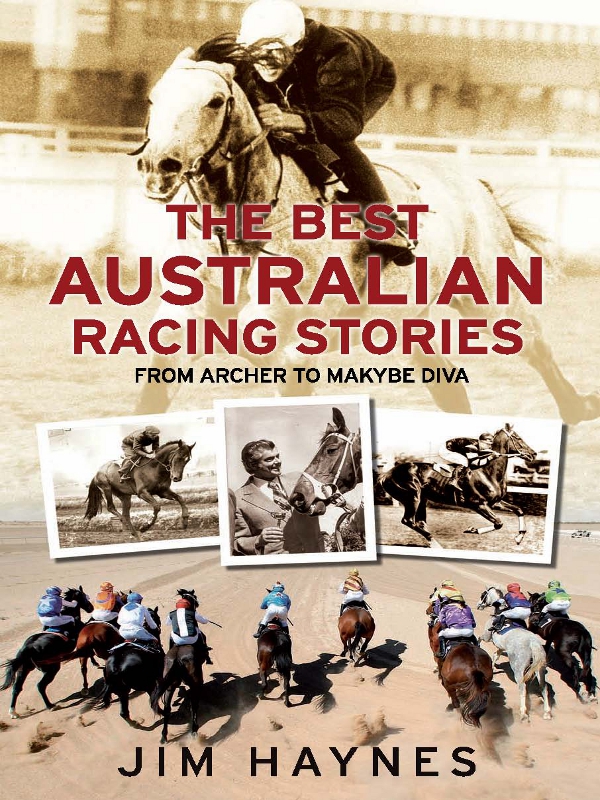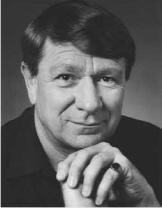Best Australian Racing Stories



Jim Haynes has taught writing, literature, history and drama in schools and universities from outback New South Wales to Britain and back again, attending race meetings whenever and wherever possible. He has two masters degrees in literature, from the University of New England and the University of Wales.
Jim has written fifteen books and compiled several volumes of Australian rhymed verse. A professional entertainer and writer since 1988, he has released many albums of his own songs, verse and humour. He still tours as an entertainer and has a weekend Australiana segment on Radio 2UE. Jim lives at Moore Park in Sydney with his partner, Robyn, and can walk to Randwick racecourse in ten minutes.
The Best
Australian
Racing Stories
From Archer to Makybe Diva
JIM HAYNES

First published in 2010
Copyright © Jim Haynes 2010
All rights reserved. No part of this book may be reproduced or transmitted in any form or by any means, electronic or mechanical, including photocopying, recording or by any information storage and retrieval system, without prior permission in writing from the publisher. The Australian
Copyright Act 1968
(the Act) allows a maximum of one chapter or 10 per cent of this book, whichever is the greater, to be photocopied by any educational institution for its educational purposes provided that the educational institution (or body that administers it) has given a remuneration notice to Copyright Agency Limited (CAL) under the Act.
Allen & Unwin
83 Alexander Street
Crows Nest NSW 2065
Australia
Phone: (61 2) 8425 0100
Fax: (61 2) 9906 2218
Email: [email protected]
Web:
www.allenandunwin.com
Cataloguing-in-Publication details are available
from the National Library of Australia
www.librariesaustralia.nla.gov.au
ISBN 978 1 74237 090 3
Set in 12/15 pt Bembo by Post Pre-press Group, Australia
Front cover images: (top) Gunsynd; (middle, L to R) Bernborough; Bart Cummings
with Think Big; Phar Lap; (bottom) Birdsville Races, 2009 (all Newspix/News Limited).
Printed and bound in Australia by Griffin Press
10 9 8 7 6 5 4 3 2 1

The paper in this book is FSC certified.
FSC promotes environmentally responsible,
socially beneficial and economically viable
management of the world's forests.
This book is for Robyn, who allows me
to indulge my racing obsession and knows
I really go to Randwick for the steak
and kidney pie in the Members'.
Contents
Our first champions: 1810â1924
  Jim Haynes
The âAge of Champions': 1924â26
  Jim Haynes
Phar Lap: Australia's favourite horse
  Jim Haynes
Why we came to love Schillaci
  Les Carlyon
Sunline: A freak of nature
  Jim Haynes
Firecracker
  Jim Bendrodt
Lonhro never liked Moonee Valley
  Jim Haynes
Father Riley's Horse
  A.B. (âBanjo') Paterson
The Bernborough story
  David Hickie
Zaimis
  Jim Bendrodt
T.J.'s top two: Tulloch and Kingston Town
  Jim Haynes
How to look at a horse
  Les Carlyon
Part 2 The Humour of the Track
A lesson in laconic
  Jim Haynes
Corn Medicine
  Harry (âBreaker') Morant
Racetrack reminiscences
  A.B. (âBanjo') Paterson
My racing problems: The punter's art
  C.J. Dennis
Five bob on Sir Blink
  Crackers Keenan
The Oil From Old Bill Shane
  C.J. Dennis
Mulligan's Mare
  A.B. (âBanjo') Paterson
The downfall of Mulligan's
  A.B. (âBanjo') Paterson
Our New Horse
  A.B. (âBanjo') Paterson
My racing problems No. 2: The fatted napes
  C.J. Dennis
The Urging of Uncle
  C.J. Dennis
The whisperer
  A.B. (âBanjo') Paterson
How Babs Malone Cut Down the Field
  Barcroft Henry Boake
Part 3 The Cup is More Than a Horse Race
The Cup is more than a horse race
  Les Carlyon
Myths and legends, poets and dreamers
  Jim Haynes
A Dream of the Melbourne Cu
p
  A.B. (âBanjo') Paterson
How the Melbourne Cup Was Won
  Henry Kendall
The Melbourne Cup
  Lesbia Harford
Bart: The King of Cups
  Bruce Montgomerie
Here's a stayer: The magic of Peter Pan
  Jim Haynes
Cup casualties
  C.J. Dennis
The bard of Cup week: C.J. Dennis
  Jim Haynes
Sailing Orders
  C.J. Dennis
The Listening Week
  C.J. Dennis
Galloping Horses
  C.J. Dennis
Why a Picnic Jane?
  C.J. Dennis
An Anticipatory Picture
  C.J. Dennis
Queens of the Cup
  Jim Haynes
Azzalin the Dazzlin' Romano
  David Hickie
Racing as it was
  A.B. (âBanjo') Paterson
The Day That is Dead
  Harry (âBreaker') Morant
Racing in Australia circa 1895
  Nat Gould
Jim Bendrodt
  David Hickie
A âpoint-to-point'
  A.B. (âBanjo') Paterson
The Cab Horse's Story
  C.J. Dennis
Randwick trainers circa 1895
  Nat Gould
A day's racing
  A.B. (âBanjo') Paterson
Our first champions: 1810â1924
JIM HAYNES
N
O NATION IN THE
world has venerated its champion racehorses as Australia has. Every few years we seem to find a new thoroughbred to admire. It is a part of our culture to have a champion to follow as each racing year unfolds. This tradition was established quite early in colonial times.
Australians have a particular obsession with racing, which is probably due to the importance of horses in the development of the colonies in the 19th century. The horse was the main mode of transport until the industrial age, and without the horse this vast country could not have been settled.
Apart from the convicts, the first settlers were mostly military men and most of them owned horsesâand, when given a chance and a holiday, they enjoyed racing them.
As settlements spread out into the bush, horses became even more essential. Entertainment was limited and race meetings became the most common way to let one's hair down after a spell of hard work and socialise after living in isolation for weeks or even months. Along with this came the love of a long weekend or a holiday, the belief that handicapping the more talented performers makes things âmore interesting', and the Australian love of gambling.
General public involvement in racing is far greater in Australia than anywhere else in the world. It is amusing to speculate that the percentage of Australians who actually attended Spring Carnival racing in Melbourne in the 1890s, if translated into similar figures in Britain, would have seen four million people attending the Derby meeting at Epsom!
Australian racing officially began in the colony of New South Wales in 1810, when the first three-day meeting was held at Hyde Park in Sydney. The winning post was approximately where Market Street meets Elizabeth Street today, and the meeting established the tradition for right-handed racing in New South Wales, that being the most convenient way of going as the sun set to the west.
Both Arab and thoroughbred horses had been imported into the colony from the time of the first European settlement, and match races had been popular prior to that first meeting in 1810.
When the 73rd Regiment was transferred to Ceylon in 1814, the colony lost its race committee and racing became uncontrolled and was banned for a time by Governor Macquarie.
The original Sydney Turf Club* was formed in 1825 and began racing at Captain Piper's racecourse at Bellevue Hill under the patronage of Governor Brisbane, who had banned unofficial meetings and dangerous races around the now dilapidated course at Hyde Park.
Colonial politics and a public insult at an STC dinner led to the next governor, Governor Darling, withdrawing his patronage from the STC in 1927. Twenty-nine members resigned in support of the governor and formed the Australian Racing and Jockey Club.
The STC raced at Camperdown and the ARJC raced at Parramatta, and from 1832 to 1841 racing was conducted on cleared scrubland at Randwick, which was known as âThe Sandy Track'.
Racing in Sydney suffered from the poor condition of tracks until 1840, when the Australian Race Committee was formed to set up a decent racetrack at Homebush. This group then decided to form a permanent race club, and the Australian Jockey Club was officially born in 1842. The Homebush track was used until the completion of the ânew' Randwick in 1860.
In Melbourne, racing started at Flemington in 1840. In 1848, 350 acres were officially designated to be a public racecourse, and a committee, which became the Port Phillip Racing Club, was set up to regulate racing. In the 1850s this club disbanded and two new clubs, the Victoria Turf Club and the Victoria Jockey Club, became bitter rivals.
It was the VTC which instituted the Melbourne Cup in 1861. The third Cup, however, was a disaster: only seven horses started after all intercolonial trainers boycotted the event when the committee refused to accept Archer's entry on technical grounds. Politics and intercolonial rivalry threatened to ruin the event until the clearer heads of both the VTC and VJC came together to form the Victorian Racing Club in 1864, and Flemington and the Cup became the property of the VRC.
